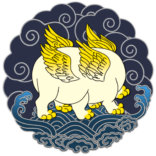
Wisdom of The Body
When first started practicing Qi Gong and Tai Ji, it is common to find it difficult to stay in the Universe Stand position for even 15 or 20 minutes.
The training of QG & TJ is to coach the brain to give up habitual patterns, and allow the body to learn new balances in which we stay in a dynamic space between relaxation and tension. It is not never static.
This is a process of allowing Qi to flow freely within the body; this is a process of allowing the body to follow the laws of physics — the light and clear floats upwards, the heavy and turbid sink downwards. When they reach an extreme state, they start to communicate and exchange places — this is when movements (Tai Ji and Qi Gong forms) are generated.
These forms were not created arbitrarily, of course!
So before starting our daily practice, it would be very helpful to read Lao Zi’s Dao De Jing and ask yourself about meaning of the lines in Chapter 4. What is “filing the sharpness, resolve the conflicts; merge with the light, assimilate with the dust.”
“挫其銳,解其紛,和其光,同其塵。“ — 道德經 · 無源第四
A Few Important Things When Practicing Qi Gong & Tai Ji
The Universe Stand is the foundation of Daoist physical cultivation. Many are taught to hold a very advanced position – horse-riding legs, holding the ball arms, dropping the body as low as possible…… In fact, this position is not posed, but a natural posture when one’s Qi has become sufficient. Before reaching to this stage, simply stand naturally, with the feet spreading to the width of the shoulders, and armpits comfortably open. Eyes should be less than 30% open without focusing on any object. Here are the basic steps:
1. Blur the senses – before trying to achieve anything, pay attention to the tightness and looseness of the body. It takes practice to grow awareness of all the body parts. Initially our mind may be busy, being distracted by thoughts. Allow this to happen, and when you notice it, gently guide the mind back to observe the internal changes. After a while, the mind will quiet down, and our senses will become blurry. It’s like spacing out – our eyes are open, and we can hear sounds, but our brain is not processing any incoming information.
2. Loosen the body – there is a form in Qi Gong called “三盤落地” (drop the three plains to the ground). The “three plains” is a Daoist jargon for shoulders, pelvis, and feet. Yang Qi moves downwards along the three Foot Yang channels, from the top of the head, along Du Mai and Jia Ji, to GB21 (on the center top of the shoulder), to the pelvic floor, via perineum, down the legs, into the feet and beyond.
3. Be mindful of KI1 (located at the center bottom of the foot) and PC8 (located at the center of the palm) – before cultivating the Dan Tian, our breaths have to be natural, smooth, and even, which will not happen unless we are completely relaxed. This cannot be forced. In fact, the harder you try to achieve it, the more constricted your diaphragm will become. This is the process of letting go, letting go of our desire to control. Slightly close the eyes, observe KI1 and PC8 from the inside. When you notice that your mind has drifted away, gently guide it back. Our ability to relax will increase if we practice this every day, at least 15 – 20 mins each time.
Once we can relax and sink our Qi into the ground, we are ready to for the next step. This is the foundation of Qi Gong and Tai Ji practice, and it typically takes at least 100 days before any fundamental changes can happen. This is called “百日築基” (building the foundations for 100 days).

